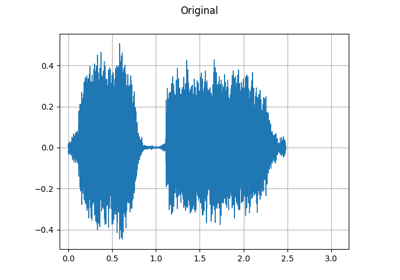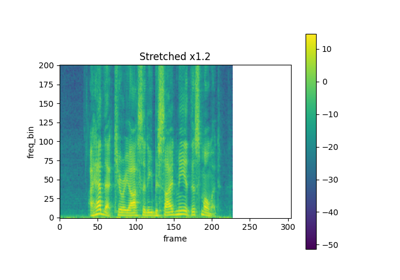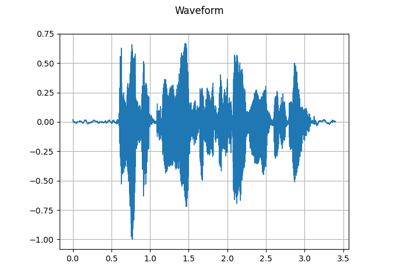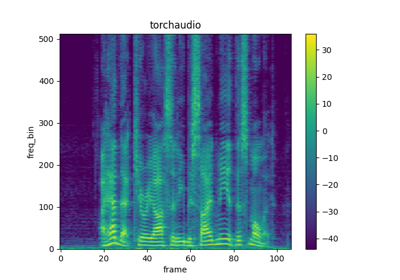torchaudio.sox_effects
Resource initialization / shutdown
-
torchaudio.sox_effects.init_sox_effects()[source] Initialize resources required to use sox effects.
Note
You do not need to call this function manually. It is called automatically.
Once initialized, you do not need to call this function again across the multiple uses of sox effects though it is safe to do so as long as
shutdown_sox_effects()is not called yet. Onceshutdown_sox_effects()is called, you can no longer use SoX effects and initializing again will result in error.
-
torchaudio.sox_effects.shutdown_sox_effects()[source] Clean up resources required to use sox effects.
Note
You do not need to call this function manually. It is called automatically.
It is safe to call this function multiple times. Once
shutdown_sox_effects()is called, you can no longer use SoX effects and initializing again will result in error.
Applying effects
Apply SoX effects chain on torch.Tensor or on file and load as torch.Tensor.
Applying effects on Tensor
-
torchaudio.sox_effects.apply_effects_tensor(tensor: torch.Tensor, sample_rate: int, effects: List[List[str]], channels_first: bool = True) → Tuple[torch.Tensor, int][source] Apply sox effects to given Tensor
Note
This function only works on CPU Tensors. This function works in the way very similar to
soxcommand, however there are slight differences. For example,soxcommand adds certain effects automatically (such asrateeffect afterspeedandpitchand other effects), but this function does only applies the given effects. (Therefore, to actually applyspeedeffect, you also need to giverateeffect with desired sampling rate.).- Parameters
tensor (torch.Tensor) – Input 2D CPU Tensor.
sample_rate (int) – Sample rate
effects (List[List[str]]) – List of effects.
channels_first (bool, optional) – Indicates if the input Tensor’s dimension is [channels, time] or [time, channels]
- Returns
Resulting Tensor and sample rate. The resulting Tensor has the same
dtypeas the input Tensor, and the same channels order. The shape of the Tensor can be different based on the effects applied. Sample rate can also be different based on the effects applied.- Return type
(Tensor, int)
- Example - Basic usage
>>> >>> # Defines the effects to apply >>> effects = [ ... ['gain', '-n'], # normalises to 0dB ... ['pitch', '5'], # 5 cent pitch shift ... ['rate', '8000'], # resample to 8000 Hz ... ] >>> >>> # Generate pseudo wave: >>> # normalized, channels first, 2ch, sampling rate 16000, 1 second >>> sample_rate = 16000 >>> waveform = 2 * torch.rand([2, sample_rate * 1]) - 1 >>> waveform.shape torch.Size([2, 16000]) >>> waveform tensor([[ 0.3138, 0.7620, -0.9019, ..., -0.7495, -0.4935, 0.5442], [-0.0832, 0.0061, 0.8233, ..., -0.5176, -0.9140, -0.2434]]) >>> >>> # Apply effects >>> waveform, sample_rate = apply_effects_tensor( ... wave_form, sample_rate, effects, channels_first=True) >>> >>> # Check the result >>> # The new waveform is sampling rate 8000, 1 second. >>> # normalization and channel order are preserved >>> waveform.shape torch.Size([2, 8000]) >>> waveform tensor([[ 0.5054, -0.5518, -0.4800, ..., -0.0076, 0.0096, -0.0110], [ 0.1331, 0.0436, -0.3783, ..., -0.0035, 0.0012, 0.0008]]) >>> sample_rate 8000
- Example - Torchscript-able transform
>>> >>> # Use `apply_effects_tensor` in `torch.nn.Module` and dump it to file, >>> # then run sox effect via Torchscript runtime. >>> >>> class SoxEffectTransform(torch.nn.Module): ... effects: List[List[str]] ... ... def __init__(self, effects: List[List[str]]): ... super().__init__() ... self.effects = effects ... ... def forward(self, tensor: torch.Tensor, sample_rate: int): ... return sox_effects.apply_effects_tensor( ... tensor, sample_rate, self.effects) ... ... >>> # Create transform object >>> effects = [ ... ["lowpass", "-1", "300"], # apply single-pole lowpass filter ... ["rate", "8000"], # change sample rate to 8000 ... ] >>> transform = SoxEffectTensorTransform(effects, input_sample_rate) >>> >>> # Dump it to file and load >>> path = 'sox_effect.zip' >>> torch.jit.script(trans).save(path) >>> transform = torch.jit.load(path) >>> >>>> # Run transform >>> waveform, input_sample_rate = torchaudio.load("input.wav") >>> waveform, sample_rate = transform(waveform, input_sample_rate) >>> assert sample_rate == 8000
- Tutorials using
apply_effects_tensor:
Applying effects on file
-
torchaudio.sox_effects.apply_effects_file(path: str, effects: List[List[str]], normalize: bool = True, channels_first: bool = True, format: Optional[str] = None) → Tuple[torch.Tensor, int][source] Apply sox effects to the audio file and load the resulting data as Tensor
Note
This function works in the way very similar to
soxcommand, however there are slight differences. For example,soxcommnad adds certain effects automatically (such asrateeffect afterspeed,pitchetc), but this function only applies the given effects. Therefore, to actually applyspeedeffect, you also need to giverateeffect with desired sampling rate, because internally,speedeffects only alter sampling rate and leave samples untouched.- Parameters
path (path-like object or file-like object) –
Source of audio data. When the function is not compiled by TorchScript, (e.g.
torch.jit.script), the following types are accepted:path-like: file pathfile-like: Object withread(size: int) -> bytesmethod, which returns byte string of at mostsizelength.
When the function is compiled by TorchScript, only
strtype is allowed.Note: This argument is intentionally annotated as
stronly for TorchScript compiler compatibility.effects (List[List[str]]) – List of effects.
normalize (bool, optional) – When
True, this function always returnfloat32, and sample values are normalized to[-1.0, 1.0]. If input file is integer WAV, givingFalsewill change the resulting Tensor type to integer type. This argument has no effect for formats other than integer WAV type.channels_first (bool, optional) – When True, the returned Tensor has dimension [channel, time]. Otherwise, the returned Tensor’s dimension is [time, channel].
format (str or None, optional) – Override the format detection with the given format. Providing the argument might help when libsox can not infer the format from header or extension,
- Returns
Resulting Tensor and sample rate. If
normalize=True, the resulting Tensor is alwaysfloat32type. Ifnormalize=Falseand the input audio file is of integer WAV file, then the resulting Tensor has corresponding integer type. (Note 24 bit integer type is not supported) Ifchannels_first=True, the resulting Tensor has dimension [channel, time], otherwise [time, channel].- Return type
(Tensor, int)
- Example - Basic usage
>>> >>> # Defines the effects to apply >>> effects = [ ... ['gain', '-n'], # normalises to 0dB ... ['pitch', '5'], # 5 cent pitch shift ... ['rate', '8000'], # resample to 8000 Hz ... ] >>> >>> # Apply effects and load data with channels_first=True >>> waveform, sample_rate = apply_effects_file("data.wav", effects, channels_first=True) >>> >>> # Check the result >>> waveform.shape torch.Size([2, 8000]) >>> waveform tensor([[ 5.1151e-03, 1.8073e-02, 2.2188e-02, ..., 1.0431e-07, -1.4761e-07, 1.8114e-07], [-2.6924e-03, 2.1860e-03, 1.0650e-02, ..., 6.4122e-07, -5.6159e-07, 4.8103e-07]]) >>> sample_rate 8000
- Example - Apply random speed perturbation to dataset
>>> >>> # Load data from file, apply random speed perturbation >>> class RandomPerturbationFile(torch.utils.data.Dataset): ... """Given flist, apply random speed perturbation ... ... Suppose all the input files are at least one second long. ... """ ... def __init__(self, flist: List[str], sample_rate: int): ... super().__init__() ... self.flist = flist ... self.sample_rate = sample_rate ... ... def __getitem__(self, index): ... speed = 0.5 + 1.5 * random.randn() ... effects = [ ... ['gain', '-n', '-10'], # apply 10 db attenuation ... ['remix', '-'], # merge all the channels ... ['speed', f'{speed:.5f}'], # duration is now 0.5 ~ 2.0 seconds. ... ['rate', f'{self.sample_rate}'], ... ['pad', '0', '1.5'], # add 1.5 seconds silence at the end ... ['trim', '0', '2'], # get the first 2 seconds ... ] ... waveform, _ = torchaudio.sox_effects.apply_effects_file( ... self.flist[index], effects) ... return waveform ... ... def __len__(self): ... return len(self.flist) ... >>> dataset = RandomPerturbationFile(file_list, sample_rate=8000) >>> loader = torch.utils.data.DataLoader(dataset, batch_size=32) >>> for batch in loader: >>> pass
- Tutorials using
apply_effects_file:




